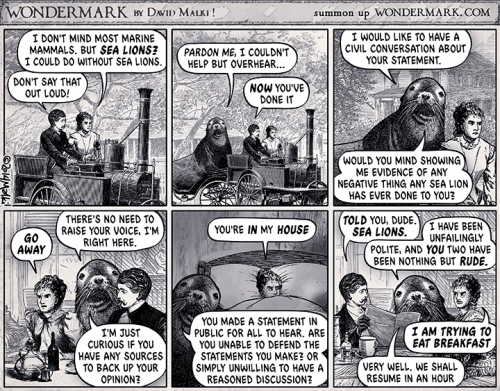I wasn’t familiar with the term “sealioning” until P. Z. Myers used it on his blog recently, linking to an explanation of why it is bad. The term refers to an online debate tactic depicted in this cartoon by David Maliki, which gives the phenomenon its name:

I’m in two minds about this. On the one hand, it isn’t hard to see that the sea lion ends up engaging in faux politeness while in fact being extremely rude. Ironically, the behavior of the sea lion provides a good reason why one might feel justified in saying they could do without sea lions!
On the other hand, it is important to ask online purveyors of dubious ideas to provide evidence for their claims, and to highlight when they are unable to do so. And so, at least at the start, it seems as though the person’s comment about sea lions ought indeed to be justified, and that asking for evidence is not inappropriate.
My concern is that “sealioning” will take its place alongside “strawmanning” as a debate tactic which people will complain about as a way to avoiding having to address legitimate criticisms and appropriate requests for evidence.
Someone in the comments on Pharyngula suggested that this was similar to the Gish Gallop. But it seems to me that the issue here is the long-term strategy to use a request for evidence in a way that tries to evoke frustration, to which one can then respond with tone trolling. And so the difference between a legitimate request for information and sealioning can only be seen in the longer term, it would seem.
What do others think?
Of related interest, I saw a status update on Facebook which asked “Do you want to build a straw man?” If I had the time, I think there could be a good parody of the song from Frozen…
















